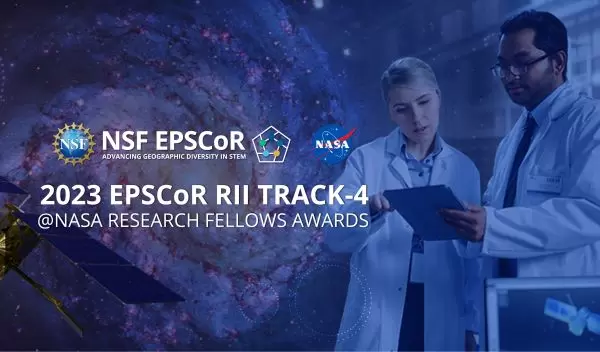
NSF announces 10 EPSCoR Track-4 awards to fund research fellowships at NASA facilities
The U.S. National Science Foundation has invested over $2.7 million in 10 projects through the Established Program to Stimulate Competitive Research (EPSCoR). This investment, in collaboration with NASA, aims to strengthen research infrastructure and advance STEM talent development at nine institutions in seven U.S. states and territories and develop the next generation of leaders in STEM.
"With access to NASA facilities and equipment, research investigators from EPSCoR jurisdictions will be able to solve challenging problems and solidify lifelong research partnerships," said NSF Director Sethuraman Panchanathan. "This dual agency partnership will also help diversify the U.S. workforce through collaborative research at the federal government level and improve the research capacity of their home institutions and jurisdictions more broadly."
The Research Infrastructure Improvement Track-4: EPSCoR Research Fellows awards will fund principal investigators from institutions with high enrollments of students from underrepresented populations in STEM. STEM faculty research fellowships will take place at NASA's Ames Research Center, Glenn Research Center, Goddard Space Flight Center, Marshall Space Flight Center and Jet Propulsion Laboratory. While building research capacity at their home institutions, fellows will learn new techniques, develop new collaborations, advance research partnerships, access unique equipment and facilities, and shift their research toward transformative new directions.
"The success of this year's joint NSF and NASA faculty fellowships highlights the remarkable dedication and ingenuity within the scientific community," said Kathleen Loftin, project manager of NASA's EPSCoR. "These fellowships are not just about funding; they are about fostering meaningful, transformative collaborations that enrich the landscape of STEM research."
The awardees and summary of each project are listed below:
-
Automating Character Extraction for Taxonomic Species Descriptions Using Neural Networks, Transformer and Computer Vision Signal Processing Architectures, University of Puerto Rico at Mayagüez — Host Site: NASA Marshall Space Flight Center
Through the development of "Descriptron," a groundbreaking artificial intelligence tool, this fellowship will use NASA's advanced imaging technology to automate the capture and description of arthropod morphological features to better understand biodiversity and accelerate the identification of undiscovered life on Earth.
-
Investigation of Erosive Wear Resistance of Ceramic Parts Produced by Additive Manufacturing, University of Alaska Anchorage — Host Site: NASA Marshall Space Flight Center
Before successfully integrating additively manufactured components into space missions, their structural integrity under various environmental conditions must be examined. This fellowship aims to study the erosive wear of additively manufactured components and develop predictive models to determine the damage caused by erosion.
-
Enhancing Flood Detection and Mapping by Using PolSAR, Metaheuristic and Deep-Learning Algorithms, University of Hawaii at Mānoa — Host Site: NASA Marshall Space Flight Center
This fellowship will advance the knowledge of synthetic aperture radar-based flood mapping by developing and validating state-of-the-art computational tools, create effective disaster response strategies during floods, and educate underserved students in the field of hydrology, remote sensing and natural hazards.
-
Next-Generation Hyperspectral Approaches to Detect Harmful Algal Blooms, College of Charleston — Host Site: NASA Ames Research Center
Harmful algal blooms (HABs) affect fisheries, tourism and human health due to the harmful toxins they disperse. Using NASA's state-of-the-art satellite technology, this fellowship will provide accurate information on the spatial and temporal distribution of HABs in coastal regions.
-
Methane Dynamics Described Through the Fusion of Site and Satellite Data in Bottomland Hardwood Forested and Non-Forested Wetlands, Murray State University — Host Site: NASA Ames Research Center
By processing and analyzing images taken from NASA satellite technology, this fellowship aims to improve the detection of greenhouse gas emissions in mineral soil wetlands and shed light on the effects of landscape position and forest composition on greenhouse gas fluxes between terrestrial ecosystems and the atmosphere.
-
Wind-Induced Noise in the Prospective Seismic Data Measured in the Venusian Surface Environment, University of Alaska Fairbanks — Host Site: NASA Glenn Research Center
This fellowship will study seismic signals from a heat-shielded broadband seismometer in NASA's simulated environment of the Venusian surface and atmosphere. The goal of this research is to create noise-cancelling techniques to hear clear seismic signals on Venus itself.
-
Bluer and Hotter: From Ultraviolet to X-ray Diagnostics of the Circumgalactic Medium, New Mexico State University — Host Site: NASA Goddard Space Flight Center
Using NASA X-ray technology, this fellowship will study gas temperatures and their interactions in cosmic ecosystems to better understand how and why new generations of stars may or may not form. -
Investigation of Two-Phase Aerosol Formation, Transport and Deposition in Aerosol Jet Printing for Submicron Manufacturing of Printed Electronic Devices, Marshall University — Host Site: NASA Marshall Space Flight Center
Research conducted through this fellowship aims to identify the aerodynamics of new aerosols jet printing technologies to create "high-resolution" device fabrication of semiconductors that will consume less power, have faster switching speeds and increase computing power. The technology will be used in a broad spectrum of electronics, such as sensors, optoelectronic devices and fine-pitch electronics.
-
Process-Structure-Property Relationship of the Hybrid Manufactured Multifunctional Mechano-Luminescence-Optoelectronic Fibers, New Mexico Institute of Mining and Technology — Host Site: NASA Ames Research Center
This fellowship aims to create a mechano-luminescence-optoelectronic fiber to be used in health monitoring wearables. The fiber will be self-powered through strain sensing and will generate electrical energy through movement and light. The technology could help enhance human presence in space.
-
Combining Physics and Deep Learning for Accurate River Discharge and Bathymetry Estimation From the Surface Water and Ocean Topography Mission, University of Hawaii at Mānoa — Host Site: NASA Jet Propulsion Laboratory
Through data acquired from NASA's Surface Water and Ocean Topography satellite, this fellowship aims to advance the study of surface-groundwater interaction and develop a new data assimilation method to estimate spatiotemporal river water depth and discharge. This work could advance water management efforts in forecasting, as frequent flooding has become a major concern due to climate change.
To learn more, visit NSF's EPSCoR and NASA's EPSCoR webpages.
